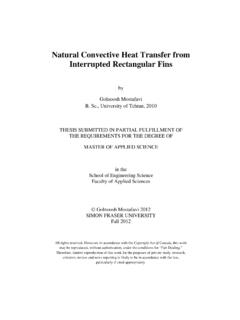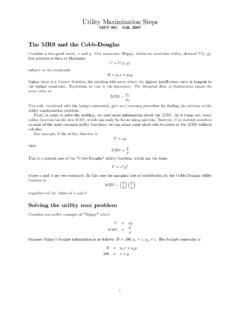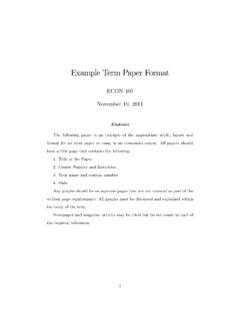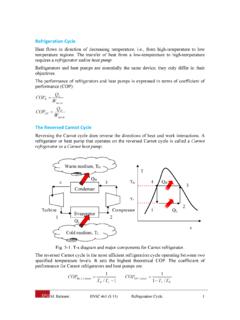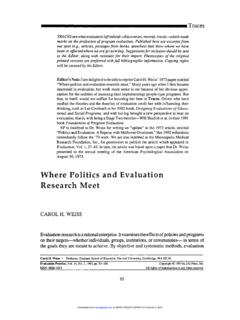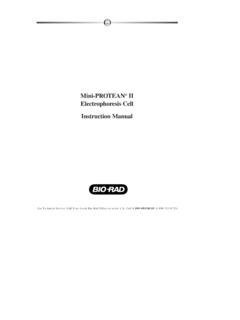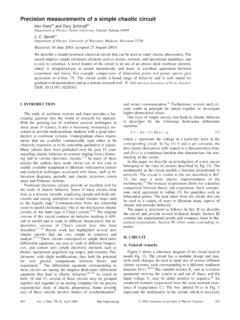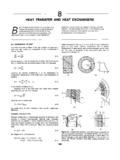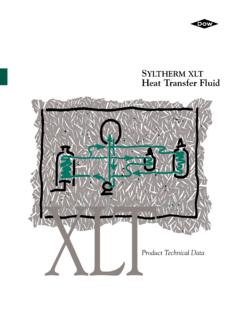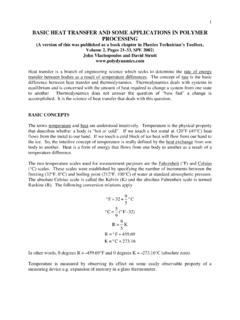Transcription of Staedy Conduction Heat Transfer - SFU.ca
1 M. Bahrami ENSC 388 (F09) steady Conduction heat Transfer 1 steady heat Conduction In thermodynamics, we considered the amount of heat Transfer as a system undergoes a process from one equilibrium state to another. Thermodynamics gives no indication of how long the process takes. In heat Transfer , we are more concerned about the rate of heat Transfer . The basic requirement for heat Transfer is the presence of a temperature difference. The temperature difference is the driving force for heat Transfer , just as voltage difference for electrical current. The total amount of heat Transfer Q during a time interval can be determined from: kJdtQQt 0 The rate of heat Transfer per unit area is called heat flux, and the average heat flux on a surface is expressed as 2/mWAQq steady heat Conduction in Plane Walls Conduction is the Transfer of energy from the more energetic particles of a substance to the adjacent less energetic ones as result of interactions between the particles.
2 Consider steady Conduction through a large plane wall of thickness x = L and surface area A. The temperature difference across the wall is T = T2 T1. Note that heat Transfer is the only energy interaction; the energy balance for the wall can be expressed: dtdEQQwalloutin For steady state operation, .constQQoutin It has been experimentally observed that the rate of heat Conduction through a layer is proportional to the temperature difference across the layer and the heat Transfer area, but it is inversely proportional to the thickness of the layer. WxTkAQCond thickness)difference eraturearea)(temp (surfacefer heat trans of rate M. Bahrami ENSC 388 (F09) steady Conduction heat Transfer 2 Fig. 1: heat Conduction through a large plane wall. The constant proportionality k is the thermal conductivity of the material. In the limiting case where x 0, the equation above reduces to the differential form: WdxdTkAQCond which is called Fourier s law of heat Conduction .
3 The term dT/dx is called the temperature gradient, which is the slope of the temperature curve (the rate of change of temperature T with length x). Thermal Conductivity Thermal conductivity k [W/mK] is a measure of a material s ability to conduct heat . The thermal conductivity is defined as the rate of heat Transfer through a unit thickness of material per unit area per unit temperature difference. Thermal conductivity changes with temperature and is determined through experiments. The thermal conductivity of certain materials show a dramatic change at temperatures near absolute zero, when these solids become superconductors. An isotropic material is a material that has uniform properties in all directions. Insulators are materials used primarily to provide resistance to heat flow. They have low thermal conductivity. A A xQ T1 T2 M. Bahrami ENSC 388 (F09) steady Conduction heat Transfer 3 The Thermal Resistance Concept The Fourier equation, for steady Conduction through a constant area plane wall, can be written: LTTkAdxdTkAQCond21 This can be re arranged as: )/()(12 WCkALRWRTTQ wallwallCond Rwall is the thermal resistance of the wall against heat Conduction or simply the Conduction resistance of the wall.
4 The heat Transfer across the fluid/solid interface is based on Newton s law of cooling: )/(1 WChARWTThAQConvs Rconv is the thermal resistance of the surface against heat convection or simply the convection resistance of the surface. Thermal radiation between a surface of area A at Ts and the surroundings at T can be expressed as: KmWTTTThAhRWRTTTTAhTTAQ ssradradradradssradsrad222441)( where = 8 [W/m2K4] is the Stefan Boltzman constant. Also 0 < <1 is the emissivity of the surface. Note that both the temperatures must be in Kelvin. Thermal Resistance Network Consider steady , one dimensional heat flow through two plane walls in series which are exposed to convection on both sides, see Fig. 2. Under steady state condition: rate of heat convection into the wall = rate of heat Conduction through wall 1 = rate of heat Conduction through wall 2 = rate of heat convection from the wall M. Bahrami ENSC 388 (F09) steady Conduction heat Transfer 4 2,2,1,1,2,1,2,2,32,321,211,11,22,2232121 111,2,222322121111,1/1///1convwallwallco nvtotaltotalconvwallwallconvRRRRRRTTQRTT RTTRTTRTTQAhTTAkLTTAkLTTAhTTQTTAhLTTAkLT TAkTTAhQ Note that A is constant area for a plane wall.
5 Also note that the thermal resistances are in series and equivalent resistance is determined by simply adding thermal resistances. Fig. 2: Thermal resistance network. The rate of heat Transfer between two surfaces is equal to the temperature difference divided by the total thermal resistance between two surfaces. It can be written: T = Q R The thermal resistance concept is widely used in practice; however, its use is limited to systems through which the rate of heat Transfer remains constant. It other words, to systems involving steady heat Transfer with no heat generation. h1 h2 T , 1 T , 2 T1 T2 T3 R1 R3 Q Q A A L1 L2 k1 k2 R2 R4 M. Bahrami ENSC 388 (F09) steady Conduction heat Transfer 5 Thermal Resistances in Parallel The thermal resistance concept can be used to solve steady state heat Transfer problem in parallel layers or combined series parallel arrangements. It should be noted that these problems are often two or three dimensional, but approximate solutions can be obtained by assuming one dimensional heat Transfer (using thermal resistance network).
6 Fig. 3: Parallel resistances. 21212121212122112121111111 RRRRRRRRRTTQRRTTRTTRTTQQQ totaltotaltotal Example 1: Thermal Resistance Network Consider the combined series parallel arrangement shown in figure below. Assuming one dimensional heat Transfer , determine the rate of heat Transfer . T2 T1 k2 k1 A2 A1 Insulation LT1 T2 Q Q Q1 Q2 R1 R2 Q = Q2 + Q2 M. Bahrami ENSC 388 (F09) steady Conduction heat Transfer 6 Fig. 4: Schematic for example 1. Solution: The rate of heat Transfer through this composite system can be expressed as: convconvtotaltotalRRRRRRRRRRRTTQ 321213121 Two approximations commonly used in solving complex multi dimensional heat Transfer problems by Transfer problems by treating them as one dimensional, using the thermal resistance network: 1 Assume any plane wall normal to the x axis to be isothermal, temperature to vary in one direction only T = T(x) 2 Assume any plane parallel to the x axis to be adiabatic, heat Transfer occurs in the x direction only.
7 These two assumptions result in different networks (different results). The actual result lies between these two results. heat Conduction in Cylinders and Spheres steady state heat Transfer through pipes is in the normal direction to the wall surface (no significant heat Transfer occurs in other directions). Therefore, the heat Transfer can be h, T T1 k2 k1 A2 A1 Insulation L1T1 T Q Q Q1 Q2 R1 R2 k3 A3 L3R3 Rconv M. Bahrami ENSC 388 (F09) steady Conduction heat Transfer 7 modeled as steady state and one dimensional, and the temperature of the pipe will depend only on the radial direction, T = T (r). Since, there is no heat generation in the layer and thermal conductivity is constant, the Fourier law becomes: rLAWdrdTkAQcylcond 2)(, Fig. 5: steady , one dimensional heat Conduction in a cylindrical layer. After integration: kLrrRRTTQrrTTkLQrLAkdTdrAQcylcylcylcondc ylcondTTrrcylcond 2/ln/ln221221,1221,2121, where Rcyl is the Conduction resistance of the cylinder layer.
8 Following the analysis above, the Conduction resistance for the spherical layer can be found: r2 r1 T1 T2 Q cond,cyl M. Bahrami ENSC 388 (F09) steady Conduction heat Transfer 8 krrrrRRTTQ sphsphsphcond211221,4 The convection resistance remains the same in both cylindrical and spherical coordinates, Rconv = 1/hA. However, note that the surface area A = 2 rL (cylindrical) and A = 4 r2 (spherical) are functions of radius. Example 2: Multilayer cylindrical thermal resistance network Steam at T ,1 = 320 C flows in a cast iron pipe [k = 80 W/ m. C] whose inner and outer diameter are D1 = 5 cm and D2 = cm, respectively. The pipe is covered with a 3 cm thick glass wool insulation [k = W/ m. C]. heat is lost to the surroundings at T ,2 = 5 C by natural convection and radiation, with a combined heat Transfer coefficient of h2 = 18 W/m2. C. Taking the heat Transfer coefficient inside the pipe to be h1 = 60 W/m2K, determine the rate of heat loss from the steam per unit length of the pipe.
9 Also determine the temperature drop across the pipe shell and the insulation. Assumptions: steady state and one dimensional heat Transfer . Solution: Taking L = 1 m, the areas of the surfaces exposed to convection are: A1 = 2 r1L = m2 A2 = 2 r2L = m2 ,211,222,2232112122111, M. Bahrami ENSC 388 (F09) steady Conduction heat Transfer 9 Fig. 6: Schematic for example 1. The steady state rate of heat loss from the steam becomes length) pipe mper ( ,1,WRTTQ total The total heat loss for a given length can be determined by multiplying the above quantity by the pipe length. The temperature drop across the pipe and the insulation are: CWCWRQCWCWRQ insulationpipe 284 Note that the temperature difference (thermal resistance) across the pipe is too small relative to other resistances and can be ignored. Critical Radius of Insulation To insulate a plane wall, the thicker the insulator, the lower the heat Transfer rate (since the area is constant).
10 However, for cylindrical pipes or spherical shells, adding insulation results in increasing the surface area which in turns results in increasing the convection heat Transfer . As a result of these two competing trends the heat Transfer may increase or decrease. r3 r1 T3 Q cond,cyl T2 T1 r2 r1 h2, T ,2 h1, T ,1 Insulation T ,1 T ,2 T1 T2 T3 Rconv,1 Rconv,2 R1 R2 M. Bahrami ENSC 388 (F09) steady Conduction heat Transfer 10 hLrkLrrTTRRTTQ convins21211212/ln Fig. 7: Critical radius of insulation. The variation of Q with the outer radius of the insulation reaches a maximum that can be determined from dQ / dr2 = 0. The value of the critical radius for the cylindrical pipes and spherical shells are: )(2)(,,mhkrmhkrspherercrcylindercr Note that for most applications, the critical radius is so small. Thus, we can insulate hot water or steam pipes without worrying about the possibility of increasing the heat Transfer by insulating the pipe.
